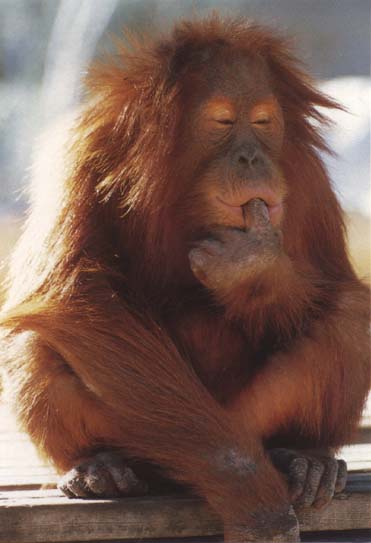 Introduction to Archaeology
and Palaeoanthropology:
Introduction to Archaeology
and Palaeoanthropology:
 Introduction to Archaeology
and Palaeoanthropology:
Introduction to Archaeology
and Palaeoanthropology:
Humanity's Journeys
Dr. Kathryn Denning
Anth 2140, Sept 2005 - Apr 2006
(Young Orangutan)
25 Oct 2005... Welcome!
Plan for the day
1 Course business/ announcements...
2 Continuing... some evolutionary basics, and our primate relatives.
Course business/ Announcements
1 The Centre for Academic Writing is running its courses: http://www.arts.yorku.ca/caw/mini-courses.html
2 Schedule
For today/tomorrow: Oct 25/26, KIT: An Overview of Primates, Atlas of Primate Skeletal Anatomy, Linda Fedigan and Birute Galdikas, The Culture of Chimpanzees
For next week, KIT: Macroevolution and the Early Primates, Something New and Different, and Cat in the Human Cradle. FAGAN Ch 8 Human origins.
Tomorrow, Weds Oct 26: Writing Assmt 1 is due in tutorial.
3 Participation
Tomorrow in tutorial: More on.... what can we learn about human beings from nonhuman primates? Come prepared to keep discussing.
Continuing... some evolutionary basics
First, Guinness evolution humour.
http://www.framestore-cfc.com/press/05pr/051003noitulove/amv_gune339_050_qt.mov
Recalling that evolution is not a simple linear process of fine-tuning adaptations - e.g. the history of life has been punctuated by massive extinctions, when the environment changed radically.
Continuing:
Recall that
 Mitosis: Normal human somatic
(body) cells have 22 pairs of autosomes (ordinary chromosomes) and one pair of
sex chromosomes. Somatic cells go through the process of mitosis: one cell with
46 single-stranded chromosomes becomes one cell with 46 double-stranded
chromosomes, then divides into two identical cells, each of which has 46
single-stranded chromosomes.
Mitosis: Normal human somatic
(body) cells have 22 pairs of autosomes (ordinary chromosomes) and one pair of
sex chromosomes. Somatic cells go through the process of mitosis: one cell with
46 single-stranded chromosomes becomes one cell with 46 double-stranded
chromosomes, then divides into two identical cells, each of which has 46
single-stranded chromosomes.
 MEIOSIS:
Gametes (sex cells, egg and sperm) are created via meiosis, which occurs in the
ovaries and testes. The first stage of meiosis is just like mitosis. Then the
cells divide again.... resulting in four cells with with 23 single-stranded
chromosomes. Crucial: in meiosis, there is mixing of genetic material
between partner chromosomes, which contributes to genetic variation in a
population. And it is meiosis that ensures that you get only one sex chromosome
(X or Y) from each parent -- X from mother or father, Y only from father.
MEIOSIS:
Gametes (sex cells, egg and sperm) are created via meiosis, which occurs in the
ovaries and testes. The first stage of meiosis is just like mitosis. Then the
cells divide again.... resulting in four cells with with 23 single-stranded
chromosomes. Crucial: in meiosis, there is mixing of genetic material
between partner chromosomes, which contributes to genetic variation in a
population. And it is meiosis that ensures that you get only one sex chromosome
(X or Y) from each parent -- X from mother or father, Y only from father.
Different forms of Genetic Inheritance
Recall that for all genes (except those on X and Y chromosomes), you have TWO copies -- one from your mother and one from your father. For some genes, there are different versions -- alleles -- with slightly different instructions for the cell. Maybe you'll have two alleles that are the same. Maybe you'll have two alleles that are different -- and in that case, which version will your body listen to?
Mendelian Inheritance:
Some traits in the body are determined by only one genetic locus. (simple inheritance or Mendelian traits). These may have multiple alleles, however.
Allele = alternate forms of a gene (flavours)
'Dominant' allele = expressed no matter what
'Recessive' allele = not expressed in the presence of a dominant allele. Need two copies for a recessive allele to be expressed.
genotype: genetic makeup of an individual
phenotype: observable physical characteristics of an individual -- the expression of a genotype
homozygous: have two copies of same allele of a gene
heterozygous: has two different alleles of a gene
Example of Mendelian inheritance in humans: ABO blood system

So... A and B are codominant
A is dominant to O
B is dominant to O
But your phenotypic blood type is clearly one type or another. It's not 40% O and 55% A with a little B mixed in.
Mendelian traits are discontinuous in their distribution.

Lots of interesting variation, including many medical conditions, are caused by straightforward Mendelian Inheritance
Online Mendelian Inheritance in Man http://www.ncbi.nlm.nih.gov/entrez/query.fcgi?db=OMIM
Remember that natural selection acts on the PHENOTYPE, not the genotype. This is why a detrimental recessive trait can stay in the population and not be selected out. ("Carriers" have one recessive allele.)
(Some recessive alleles can exert an influence on the phenotype, but it is usually not strong.)
Polygenic Inheritance
Many, many phenotypic traits are determined by multiple genes acting together (polygenic), rather than by a single gene (Mendelian). This results in a range of expressions.
e.g. not merely dark brown or pale pink, but many shades in between
e.g. not merely two different heights of humans, but many
Polygenic traits have a continuous distribution, below.

Polygenic traits in humans, generally speaking, include skin colour, hair colour, stature, eye colour, face shape, nose shape, fingerprint pattern.
Do Genes Determine Everything?
Certainly not. The genotype does not absolutely determine the phenotype.
Environment plays a substantial role in how genes are expressed. (e.g. nutrition and stature)
OVERALL... much is still being learned about genetics -- it is not as simple as we once thought -- but the principles above are generally true.
Evolution in action
Evolution: A change in the frequency of alleles from one generation to the next
Evolution is the result of
a) the production and redistribution of variation (inherited differences between individuals)
e.g. production of variation via mutation (novel arrangements of DNA), but note that the mutation has to occur in the gametes to be passed on to the next generation and thus evolutionarily significant
e.g. redistribution of variation via gene flow, or mating between different populations of the same species
e.g. genetic recombination via meiosis, which shuffles the combinations
e.g. redistribution/reduction of variation via genetic drift (including founder effect)... many significant examples in human microevolution
b) natural selection acting on this variation (because inherited differences among individuals differentially affect their ability to reproduce successfully)
Non-human examples include:
* Galapagos finches (average population beak size changing in response to seeds changing in response to drought in 1977... and then changing back again in response to wetter climate in 1982-83 !),
* peppered moths and industrial melanism near Manchester: the population overall getting darker or lighter, in response to tree bark getting darker or lighter from coal dust (predation worse for the moths that don't blend in)
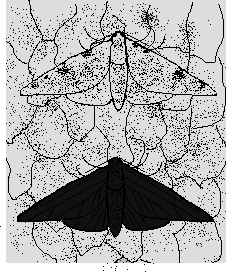
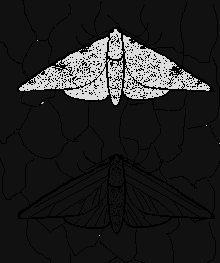
* antibiotic-resistant strains of pathogenic micro-organisms. In each generation of bacteria, the ones that survive are the ones that reproduce. The bacteria that are resistant to antibiotics are the ones that make more bacteria.... which in turn are resistant to antibiotics.... n.b. evolution in bacteria is fast because of short generation time and because they swap genes with other bacteria.
Often, evolution is not totally straightforward in practice....
One example in humans: Malaria and sickle-cell anemia. But n.b. this is actually a balanced polymorphism, where natural selection is working in two opposite directions at once, which holds the different allele frequencies in balance... instead of gradually eliminating one

Normal red blood cells and a sickle cell.
Hemoglobin molecules in the red blood cells carry oxygen to the body's tissues.
Alleles for hemoglobin:
Hb(n) = normal Hb --> normal cells
Hb(s) = hemoglobin that doesn't carry as much oxygen, and which crystallizes inside the red blood cell, causing it to become sickle-shaped. These sickled cells are fragile, can't carry much oxygen, and can't get down the tiny capillary blood vessels to the body's tissues.... resulting in pain, anemia, general disability, and if left untreated, early death.
Note: these alleles are BOTH expressed (one is not dominant to the other)
If a person has one copy of Hb(s), they can be quite fine.
If they have two copies of Hb(s), they are usually very ill.
So why hasn't the gene for sickle cell simply vanished over time due to natural selection working against it?
Because in one circumstance, it's actually an ADVANTAGE to have one copy of Hb(s): in areas with a high prevalence of malaria.
The malaria parasite (a protozooan, genus Plasmodium) is transmitted by mosquitoes, and lives in the red blood cells, where it obtains the oxygen that it needs to live.
Malaria can be fatal, and often hits children (i.e. before reproductive age).
The Plasmodium can't live in sickle cells! So... if you have some sickled cells... your malaria infection isn't as bad as if you have all normal red blood cells!
So the effects of sickle cell anemia push the population's Hb alleles in one direction, while the effects of malaria push the population's Hb alleles in the other direction.
Another source of DNA: The Mitochondrion
- an organelle known as "The Powerhouse" of the cell.
- plural "mitochondria"
The Endosymbiont Theory of how mitochondria became part of eukaryotic cells.... i.e. that mitochondria were once free-living little bacteria which began to live inside larger cells ... explains why mitochondria still have their own division cycle, and thus why mtDNA replicates separately from the nuclear DNA of the eukaryotic cell.
Human Mitochondrial DNA is -- like most bacterial/prokaryote DNA -- organized in a closed circle (below left), unlike Human Nuclear DNA, which is in a double helix (below right).
Human mitochondrial DNA genome has 37 genes. Human nuclear DNA has 46 chromosomes (23 pairs) and about 30 000 genes.

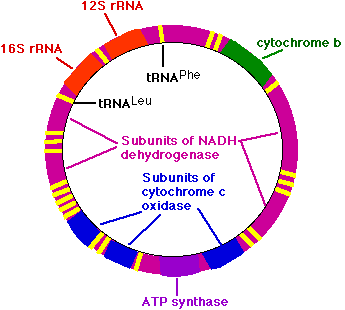
Important facts about mtDNA:
- as a rule, mammals inherit mitochondria only from their mother... though a few paternal mitochondria do get from the sperm into the egg during the process of fertilization, they are generally destroyed quickly www.sciencenews.org/articles/20000101/fob3.asp
- there is a bit of gene-swapping occasionally between mitochondria and the nucleus -- DNA moves around rather more than was once believed (and chromosomes are also quite messy, i.e. there are many non-functioning DNA segments there)
- mitochondrial DNA mutates/evolves quickly compared to nuclear DNA... and at a relatively stable rate. This, coupled with the fact that you inherit mtDNA only from your mother, makes the mitochondrial molecular clock possible.... although there's a lot of dispute about finetuning the clock!
Y chromosomes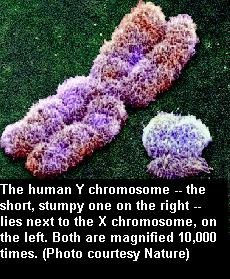
- remember that... generally, males have X and Y chromosomes, while females have only X and X
- so... Y chromosomes come only from the father, via sperm
- thus Y chromosomes are useful for tracing paternal inheritance, much as mitochondria are useful for tracing maternal inheritance
- X chromosomes can also be used, but an individual's X chromosome(s) can come from the father or mother -- so there's no real advantage to that
- nuclear DNA is really hard to use for tracing evolutionary change because it gets shuffled around so much from generation to generation
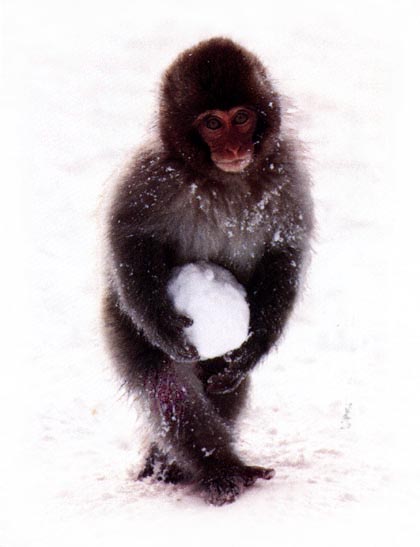
Meet the Relatives.... Your Living Cousins, the Primates!
includes prosimians, monkeys, apes
230 species of nonhuman primates (and dropping...)
Nonhuman primates are very good at being what they are, i.e. they are not pale imitations of us -- counter to earlier (religious and secular) notions of us evolving towards perfection, or monkeys being degenerate humans, having fallen from grace
Primate Characteristics (including us!)
Mammals - Placental (i.e. not marsupials or monotremes)
Body hair
Long gestation period with live birth (i.e. not eggs)
mammary glands
varied teeth ( a combination of incisors, canines, premolars, molars)
homeothermy
increased brain size
lots of capacity for learning and flexible behaviour
overall, not all that specialized
Dental formula:
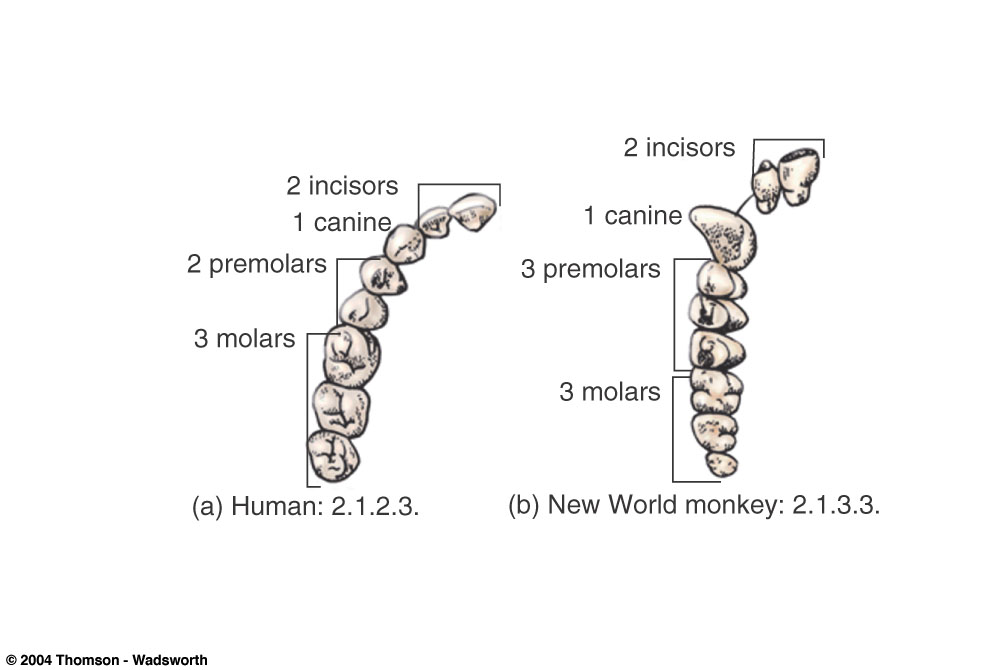
Primate dental variations:
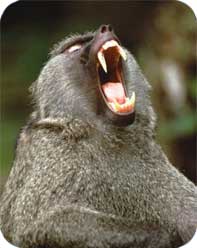
Humans and apes quite similar, except humans have reduced canine size compared to all primates, and also no diastema (space to accommodate large canine). Prosimians have interesting specializations including dental comb for combing through fur or obtaining sap from trees.
Right: baboon canines
Primate Limbs
A tendency towards erect posture.
Hands and feet possess grasping ability.
Features of the hands and feet:
5 digits on hand and feet
Opposable thumb
partially opposable great toe
Tactile pads enriched with sensory nerve fibers at the ends of digits
Primate Senses and the Brain
Color vision is a characteristic of all diurnal primates, nocturnal primates lack color vision.
Depth perception is made possible by eyes positioned forward on the front of the face.
Decreased reliance on the sense of smell.
The brain has expanded in size and become increasingly complex.
Forward-placed eyes... stereoscopic
vision allows depth perception... seen in most predatory species and in many
arboreal species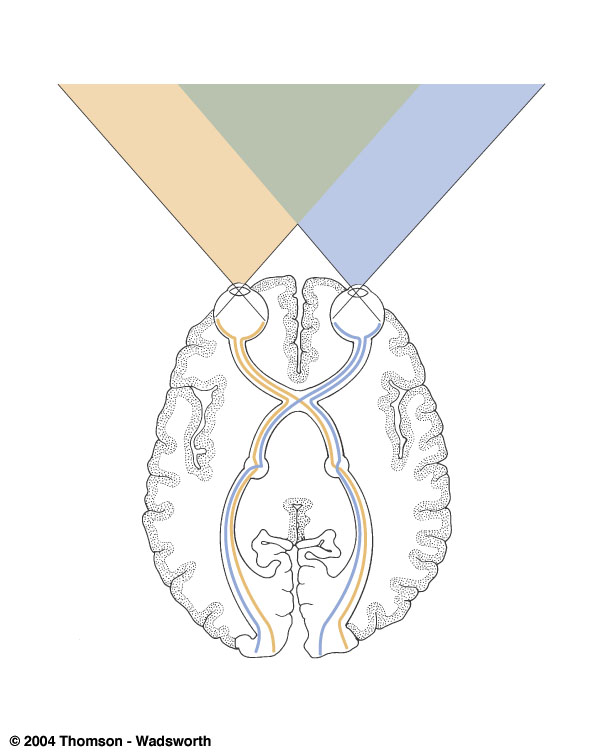 ...
compare to rabbits or deer, where eyes are on sides of head
...
compare to rabbits or deer, where eyes are on sides of head

Primate Maturation
Longer periods of gestation
Reduced numbers of offspring
Delayed maturation
Extension of the entire life span.